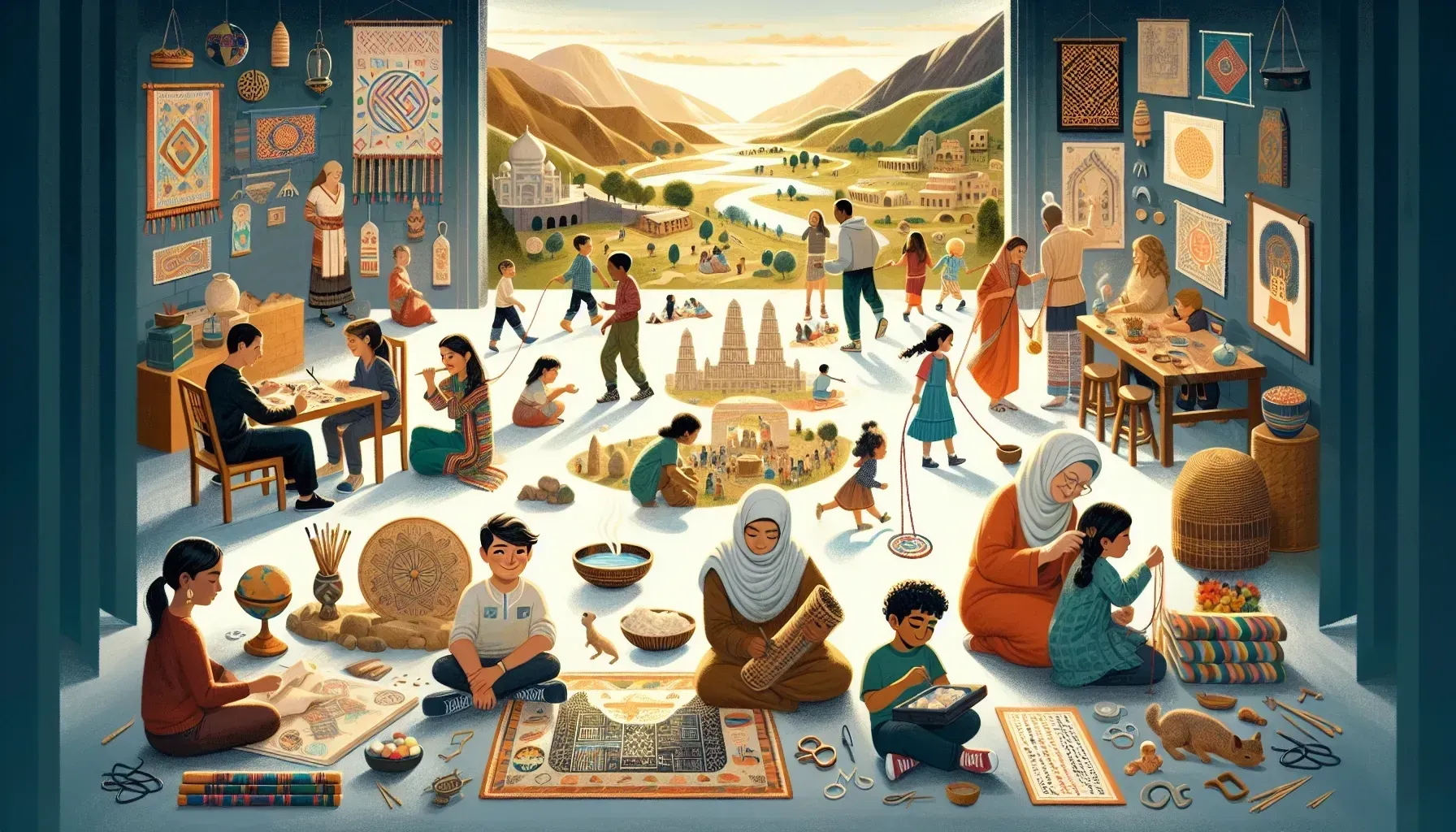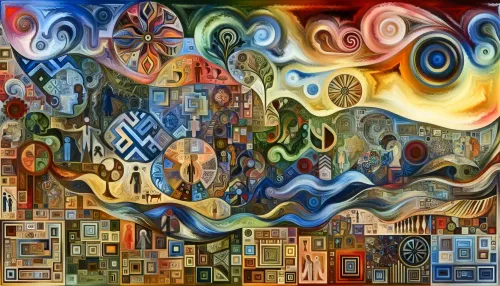Weaving Threads of the Past: Cultural Heritage as a Bridge in Autism Education

Autism, a complex neurobehavioral condition, often requires specialized educational approaches that cater to the unique needs of autistic children. While modern teaching methods are valuable, incorporating cultural heritage into autism education can provide a rich tapestry of learning experiences. This article explores the integration of cultural traditions and practices to enhance various developmental aspects in autistic children, offering a holistic educational perspective.
Storytelling is an age-old tradition present in cultures worldwide. For autistic children, the art of storytelling serves as a profound tool for honing communication skills. Folktales, with their diverse narratives and characters, can captivate the imagination of autistic children, fostering language development and social understanding in an engaging manner.
The Role of Cultural Heritage in Autism Education
Parents and educators can leverage folktales to facilitate meaningful interactions with autistic children. By using stories as a platform to discuss emotions, moral dilemmas, and interpersonal relationships, autistic individuals can enhance their comprehension of abstract concepts while developing empathy and a deeper understanding of societal norms.
Storytelling Pedagogy: Enhancing Communication Skills
In addition to verbal storytelling, visual aids such as storyboards and puppets can further enhance the storytelling experience, catering to different learning modalities. Through this approach, cultural heritage becomes an invaluable resource for nurturing vital communication skills in autistic children.
Music has universal appeal, transcending linguistic and cultural barriers. When integrated into autism education, traditional songs and chants offer multifaceted benefits, particularly in language acquisition and cognitive development.
Related Article: Beyond Boundaries: Experiencing Autism Through a Multicultural Lens
Cultural Songs: A Tool for Language Learning
Cultural songs provide rhythmic patterns and repetitive lyrics that aid in language learning for autistic children. The melodic structure facilitates memorization and verbal expression while fostering auditory processing skills. Additionally, participation in group singing fosters a sense of community and shared experience, promoting social integration and collaborative learning among autistic individuals.
The utilization of indigenous musical traditions not only instills linguistic competence but also cultivates an appreciation for cultural diversity. By immersing autistic children in the melodic tapestry of their cultural heritage, educators can holistically support language acquisition and cognitive growth.
Artistic expression plays a pivotal role in the holistic development of autistic children. Traditional crafts embedded within cultural heritage offer a platform for sensory exploration, fine motor skill refinement, and imaginative self-expression.
Engaging in activities such as origami, pottery, or textile crafts connects autistic children with their cultural roots while stimulating tactile perception and motor coordination. Through these creative pursuits, individuals with autism manifest their artistic inclinations and refine their dexterity.
Traditional Crafts: Developing Fine Motor Skills
Moreover, traditional crafts provide a pathway for self-esteem enhancement and emotional regulation. As autistic individuals immerse themselves in crafting traditions passed down through generations, they derive a sense of accomplishment and pride from mastering new skills within the framework of their cultural heritage.
Traditional writing forms offer unique opportunities for enhancing focus, attention to detail, and fine motor control in autistic children. Calligraphy, exemplifying exquisite penmanship found in various cultures, serves as an unconventional yet compelling avenue for refining fine motor skills.
By learning calligraphy techniques specific to their cultural background, autistic individuals engage in intentional movements that demand precision and concentration. This intricate art form not only cultivates patience but also hones visual-motor coordination as participants navigate through intricate strokes to create elegant characters.
Related Article: Festive Spectrum: Adapting Cultural Festivals for the Inclusion of Autistic Children
Calligraphy: Improving Focus and Control
The meditative nature of calligraphy provides a calming effect appropriate for managing sensory sensitivities commonly observed in autism. Embracing calligraphic traditions encourages autistic children to channel their focus into purposeful movements within the realm of their cultural inheritance.
Traditional sports and games rooted in cultural heritage offer autistic children opportunities for physical engagement, social interaction, and skill development within structured play settings. These heritage games foster inclusivity while providing avenues for holistic physical development.
Participation in ancient sporting activities not only promotes physical fitness but also encourages teamwork, fair play, and strategic thinking among autistic children. Through these games deeply embedded in cultural traditions, individuals with autism build social skills through cooperative play while experiencing traditional forms of recreation specific to their heritage.
The emphasis on rules and structured gameplay intrinsic to legacy games aids in fostering discipline and adherence to social norms. By integrating these culturally significant pastimes into autism education, caregivers concurrently nurture physical wellness and social competencies in autistic individuals.
Legacy Games: Fostering Teamwork and Fitness
Mandalas intricate geometric patterns with symbolic significance serve as potent tools for promoting concentration, relaxation, and emotional well-being in autism education. Rooted in diverse cultural practices, mandalas provide a canvas for artistic expression and inner contemplation.
Creating mandalas entails mindful focus on intricate designs, facilitating improved concentration skills among autistic children. This process fosters a sense of achievement through the completion of elaborate patterns while concurrently promoting relaxation akin to meditative practices.
Furthermore, the act of coloring mandalas offers therapeutic benefits by enabling emotional expression through art. Autistic individuals find solace in the rhythmic action of coloring within predetermined structures cultivating self-soothing mechanisms essential for emotional regulation within culturally resonant therapeutic practices.
Mandalas: Concentration and Art Therapy Benefits
Archaeological explorations stand as experiential educational opportunities that unfold history's mysteries before the curious minds of autistic children. Delving into archaeological sites or participating in simulated excavations fosters cognitive growth by combining tactile exploration with historical inquiry within cultural contexts.
Through hands-on engagement with relics from bygone eras specific to their cultural lineage, autistic individuals cultivate historical knowledge while refining observational skills. The tangible connection with cultural antiquities fosters a deepened appreciation for inherited traditions while stimulating intellectual curiosity within autism education.
Additionally, archaeological pursuits nurture problem-solving abilities as participants piece together fragments of history an inherently engaging experience that transcends traditional classroom learning methods. By integrating archaeological explorations into autism education, educators invigorate cognitive development through interactive historical discovery.
Archaeological Explorations: Boosting Cognitive Skills
Culinary traditions encapsulate sensory-rich experiences that beckon autistic children to embark on flavorful journeys through their cultural heritage. Participating in traditional cooking lessons introduces sensory exploration intertwined with culinary artistry stimulating olfactory senses while engaging tactile sensitivity.
The preparation of culturally significant dishes prompts sensory exploration the amalgamation of varied textures, aromas, temperatures culminating in an immersive gastronomic experience tailored to individual preferences within autism education frameworks. Moreover, cooking activities foster life skills such as following directions and understanding food preparation techniques.
Cultural cooking embodies shared experiences deeply rooted in familial customs a facet that transcends pure gastronomy nurturing interpersonal bonds through communal meal preparations. By incorporating culturally resonant cooking lessons into autism education programs, caregivers imbue culinary heritage with sensory enrichment tailored to individualized needs.
Incorporating diverse elements of cultural heritage into autism education yields multifaceted benefits that extend beyond standard pedagogical approaches. By intertwining traditional practices with contemporary autism education strategies, educators provide meaningful opportunities for holistic development tailored specifically to the unique needs of autistic children within the rich tapestry of cultural heritage.
Frequently Asked Questions
Storytelling plays a crucial role in autism education by helping autistic children develop communication skills. Folktales engage their imagination, allowing them to explore emotions and social norms, which enhances language development and empathy through meaningful interactions.
Cultural songs offer rhythmic patterns and repetitive lyrics that facilitate language acquisition for autistic children. The melodic structure helps with memorization and verbal expression, while group singing fosters social integration and collaborative learning among peers.
Traditional crafts enhance fine motor skills and creativity in autistic children. Engaging in activities like origami or pottery connects them to their cultural roots while promoting sensory exploration, emotional regulation, and self-esteem through the mastery of new skills.
Calligraphy enhances focus and fine motor control in autistic children by requiring precision and concentration. Learning this art form encourages patience and visual-motor coordination, while its meditative nature helps manage sensory sensitivities commonly experienced in autism.
Legacy games rooted in cultural heritage promote physical fitness, teamwork, and social interaction among autistic children. These structured play settings foster discipline and adherence to social norms while enhancing cooperative play skills through traditional recreational activities.
Mandalas promote concentration and relaxation for autistic children through artistic expression. Creating intricate designs fosters a sense of achievement while coloring offers therapeutic benefits, enabling emotional expression and self-soothing mechanisms essential for emotional regulation.
Archaeological explorations provide hands-on educational experiences that stimulate cognitive growth in autistic children. Engaging with historical artifacts fosters observational skills and problem-solving abilities while deepening their appreciation for cultural traditions through interactive historical discovery.
Cultural cooking lessons offer sensory-rich experiences that engage autistic children's olfactory senses and tactile sensitivity. Preparing traditional dishes fosters life skills such as following directions while nurturing interpersonal bonds through shared culinary traditions within families.
Integrating cultural heritage into autism education enriches learning experiences by providing diverse approaches tailored to individual needs. This holistic perspective supports various developmental aspects, fostering communication, creativity, and social skills essential for the growth of autistic children.
Yes, storytelling can significantly enhance empathy in autistic children. By discussing emotions and moral dilemmas presented in folktales, they can better understand interpersonal relationships and societal norms, which are crucial for their social development.
Check Out These Related Articles

Intersecting Identities: The Influence of Heritage on Autistic Children's Growth

A World of Views: Contrasting Global Stigmas and Support Systems for Autism

Amplifying Diverse Voices: Insights Across Cultures in Autism Care
